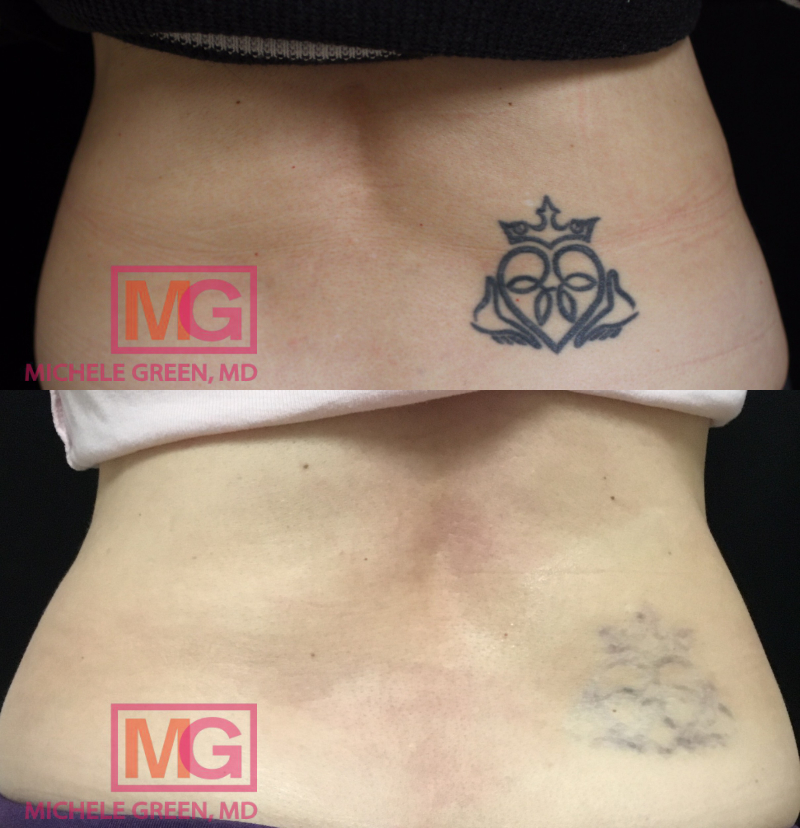Laser Tattoo Removal
Laser tattoo removal is regarded as the safest and most effective way to eliminate unwanted tattoos. Laser treatments target the pigment in tattoo ink while leaving the surrounding skin unaffected. There is minimal downtime and few potential side effects, making laser tattoo removal a simple and accessible option for those who no longer want their tattoos. At her private dermatology office in NYC, Dr. Green offers the gold standard, the AlexTriVantage laser, for laser tattoo removal. The AlexTriVantage is safe and effective for patients of all skin types and tones, including darker skin, which may be more prone to unwanted side effects with other laser treatments.
The laser tattoo removal process is straightforward, and a session can last between 5 to 30 minutes, depending on the tattoo’s size. During treatment, the laser energy is absorbed by the tattoo pigment, causing the ink to shatter into smaller particles. These smaller particles are then small enough for the body’s immune system to remove, leading to lightening of the tattoo and a visibly faded appearance. Different ink colors absorb different wavelengths of light, so different laser lights are necessary to treat various tattoo hues. It’s important to have laser treatments, including laser tattoo removal, performed by an expert to ensure safety, effectiveness, and the best results, while also preventing side effects like hypopigmentation, hyperpigmentation, and scarring.
Dr. Michele Green, based in New York City, is an internationally recognized expert in cosmetic dermatology with over 25 years of experience providing the world’s most discerning clients with top non-invasive treatments, including laser tattoo removal. She uses the latest laser technologies to remove unwanted tattoos of various pigments, inks, and sizes. Dr. Green adopts a holistic, less-is-more approach to skin rejuvenation, customizing each patient’s treatment plan to meet their specific concerns and aesthetic goals most effectively. She is consistently recognized as one of NYC’s best dermatologists by Castle Connolly, New York Magazine, Super Doctors, and the New York Times for her commitment to her patients and her expertise. When you consult with Dr. Green about laser tattoo removal at her state-of-the-art clinic, she will develop a personalized treatment plan tailored to your needs.
How does laser tattoo removal work?
Advancements in laser technology have made laser tattoo removal the most effective way to permanently eliminate tattoo pigment without harming the surrounding skin. Tattoo ink resides in the dermis, the skin layer beneath the outermost layer. When a tattoo is first applied, the ink particles are too large for the immune system to recognize, which is why tattoos are generally considered permanent. During laser tattoo removal, the tattoo pigment absorbs the laser energy, causing the ink to shatter into smaller particles. These broken-down ink particles become small enough for the immune system to remove them from the body, resulting in a lightening of the treated area and a visibly faded tattoo. Different ink colors absorb different wavelengths of light, which is why specific laser wavelengths are needed for different tattoo colors. Black tattoos are the easiest to remove because they absorb all wavelengths of laser light.
The number of sessions needed varies based on the tattoo’s size, color, and the type of ink used. The patient’s aesthetic goals also influence the total number of treatments required. Some patients may only need a few laser sessions to sufficiently fade the tattoo for a cover-up. Those seeking complete removal will need additional sessions. Laser treatment is safer than many other methods like dermabrasion, cryosurgery, salabrasion, and excision, because it only targets the pigment in the tattoo ink and does not harm the surrounding skin.
What laser is used for tattoo removal?
At her private dermatology practice in NYC’s Upper East Side, Dr. Green uses the Candela AlexTriVantage for laser tattoo removal. The Alex TriVantage is a unique Q-switched laser/Nd-YAG that is gentle and safe for all skin types, including darker skin and Asian skin. The Q-switched laser is a high-intensity pulsed beam that delivers laser light in short bursts, with pulse durations of nanoseconds. When the laser light penetrates the skin in the treated area, the tattoo pigment absorbs the energy and converts it to heat, shattering the tattoo ink particles into smaller pieces. The immune system can then remove these smaller ink particles, creating a lightning effect in the treated area.
One advantage of this laser is its ability to remove tattoos with different ink colors without damaging surrounding skin. The Alex TriVantage safely and effectively removes tattoo ink with minimal discomfort. Blue and green inks are known for their stubbornness during laser removal, but Alex TriVantage can break down even the most resistant blues and greens. The device can be used on all areas of the body, including the face, neck, arms, legs, and back. Additionally, the AlexTriVantage laser treatment effectively reduces the appearance of other unwanted pigmentation types, such as sun spots, freckles, and birthmarks.
What is the process like for laser tattoo removal with Dr. Michele Green in NYC?
The first step is to schedule a consultation with Dr. Green at her private dermatology office located in Manhattan’s Upper East Side neighborhood. During your consultation, Dr. Green will gather a thorough family and medical history, physically examine the unwanted tattoo, and review any previous cosmetic procedures you may have had. She will then make recommendations regarding the best cosmetic treatment options suited to your skin type, tone, and the type of tattoo you have. If you are a good candidate for laser tattoo removal, the procedure may be performed on the same day or scheduled for a later date, based on time availability and your preference.
Depending on the size and location of the tattoo, a topical or local anesthetic will be used to numb the area before the procedure. If a numbing cream is used, it should be applied to the tattoo one hour before the laser treatment to ensure it has enough time to take effect. Once the area is cleaned and sterilized with alcohol, Dr. Green uses the AlexTriVantage to deliver high-intensity laser light to the tattoo pigment. The laser tattoo removal process typically lasts between five and thirty minutes, depending on the size of the tattoo. Afterward, an antibiotic ointment and a bandage will be applied to the treated area to promote healing and protect the skin while it remains sensitive.
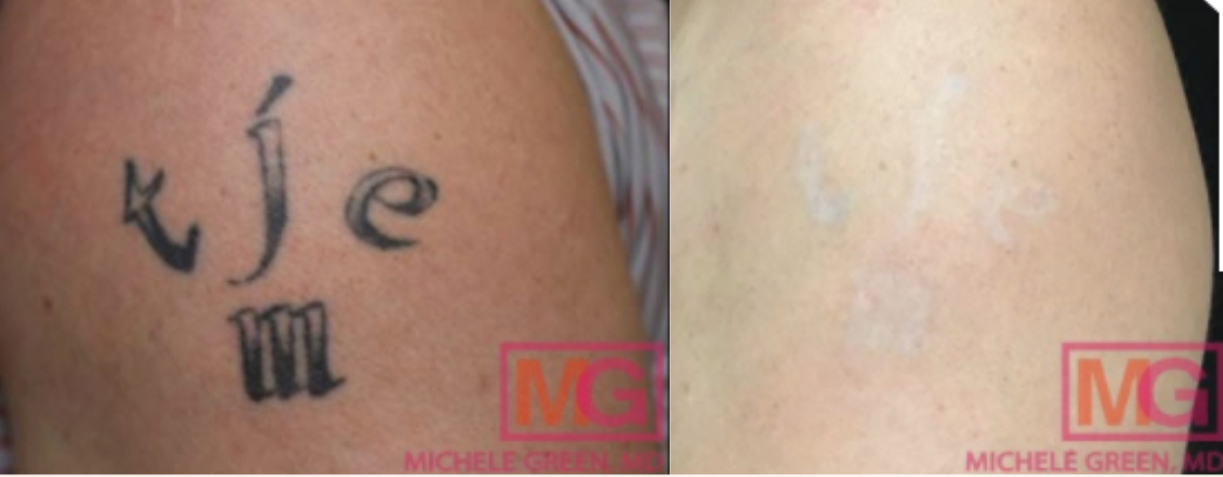
AlexTrivantage laser for tattoo removal, 8 treatments
What are the side effects of laser tattoo removal treatment?
Modern laser technology has made tattoo removal safer and easier than ever. Still, some common side effects in the treated area include blistering, scabbing, peeling, redness, bruising, and tenderness. These usually heal on their own within one to two weeks after treatment. Though less common, another possible side effect can be hypopigmentation, which happens when the laser removes pigment from both tattoo ink and skin cells, leaving patches of skin that are lighter than the surrounding area. Mild hypopigmentation may resolve naturally, but more severe cases are likely permanent. Long-term skin discoloration after laser tattoo removal is rare but occurs more often in people with darker skin. The chances of experiencing severe hypopigmentation and other side effects like hyperpigmentation and scarring are greatly reduced when a specialist, such as board-certified dermatologist Dr. Green in NYC, performs the procedure.
What to expect after laser tattoo removal
One of the biggest benefits of laser tattoo removal compared to other methods is that it is completely non-invasive and targets the tattoo ink directly while leaving the surrounding skin untouched. Because of the laser technology used for removing unwanted tattoos, there is minimal discomfort, little downtime, and few potential side effects after the procedure. Keeping the area covered with antibiotic ointment and a bandage during the first few days after each session will support healing and help prevent skin irritation or damage. It’s also important to avoid sun exposure in the treated area, as laser treatment increases the skin’s photosensitivity, making it more vulnerable to UV damage. After a laser tattoo removal session, patients can usually resume most of their normal activities. However, strenuous exercise, baths, hot tubs, swimming pools, and saunas should be avoided for several days to prevent worsening side effects and to help the skin heal properly. When you have laser tattoo removal with Dr. Green at her private dermatology practice in NYC’s Upper East Side, she will give you all the necessary aftercare instructions to achieve and maintain the best results.
How long does laser tattoo removal take?
Laser tattoo removal is a simple process that is usually faster and easier than getting a tattoo. Depending on the size of the tattoo, a laser removal session typically lasts between five and thirty minutes. Other factors affecting the session length include the age, depth, and color of the tattoo. The type of laser, such as picosecond or nanosecond lasers, can also influence how long the process takes. If multiple tattoos are being removed during one session, more time will be needed. While each session is generally brief, complete removal of an unwanted tattoo requires several treatments, each spaced 6-8 weeks apart. Dr. Green will evaluate your tattoo during each follow-up to ensure you are making progress toward a clearer appearance.
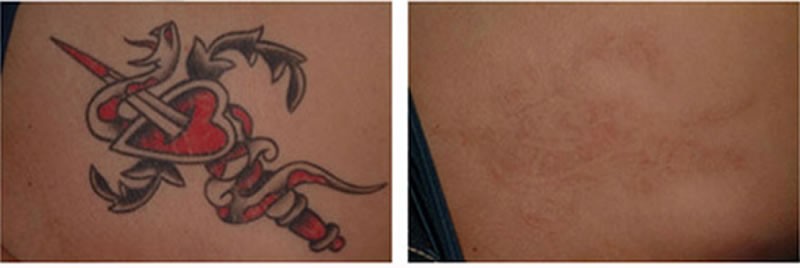
How long between laser tattoo removal sessions?
The laser tattoo removal process takes time. Usually, multiple treatment sessions are needed to see the desired results, with each session spaced 6-8 weeks apart. Laser tattoo removal cannot completely remove a tattoo in just one session because the pigment is broken down layer by layer. The immune system then filters out the treated ink particles through the liver. With each session, the tattoo will gradually lighten. It should become visibly lighter each week as white blood cells continue to remove the ink from the skin. Noticeable results may appear after around the third treatment session, though this can vary from person to person. Since the success of laser tattoo removal also depends on your immune system, overall health can greatly influence how quickly your body can eliminate the broken-down ink particles. When you receive laser tattoo removal treatments with Dr. Green in NYC, she will check on your tattoo’s progress during each follow-up session.
How many laser tattoo removal sessions are needed?
The number of treatment sessions needed to fully remove an unwanted tattoo will ultimately depend on several factors, including the type of tattoo ink, tattoo colors, the patient’s skin type, and the age, depth, and location of the tattoo. Because tattoo ink has many different chemical compositions and a wide variety of colors used by tattoo artists, it can be difficult to predict exactly how many laser sessions will be necessary for complete removal. Usually, small tattoos with black ink are the easiest to remove, while older, multi-colored tattoos tend to be more challenging. Additionally, the depth of ink in amateur tattoos can range from the epidermis (the outermost skin layer) to the dermis (the deeper layer). In professional tattoos, the ink is typically deposited evenly into the dermis. It may take six to twelve sessions to remove some multi-colored tattoos. Laser tattoo removal is a gradual process, as the laser breaks down the tattoo ink layer by layer. Unwanted side effects, such as severe hypopigmentation, hyperpigmentation, and scarring, are more likely with aggressive laser treatments.
When you consult with internationally renowned, board-certified dermatologist Dr. Michele Green in NYC, she will take a comprehensive medical history, physically examine your unwanted tattoo, and review any previous cosmetic treatments. She will collaborate with you to create a personalized plan for laser tattoo removal and establish a timeline that best fits your needs. Dr. Green will monitor your progress during each follow-up session to ensure you are progressing toward fully removing your unwanted tattoo.
Does laser tattoo removal actually work?
Yes! Laser tattoo removal is currently one of the safest and most effective methods for removing unwanted tattoos without damaging the surrounding skin. Laser tattoo removal uses non-invasive laser energy pulses to penetrate the skin and break down tattoo pigments into smaller particles. Once broken down into smaller pieces, the ink particles are naturally eliminated by your immune system. You can expect visible improvements after just the first treatment; however, the color and size of your tattoo may require multiple sessions, spaced 6-8 weeks apart, to achieve the desired results. The effectiveness of laser tattoo removal can vary significantly among individuals, as it depends on several factors, including skin type characteristics such as size, color, and depth of the tattoo.
For safe laser tattoo removal, consult a trusted board-certified dermatologist like Dr. Michele Green, who has the expertise and medical training to ensure effective treatment and prevent unwanted side effects. It is essential to follow through with your laser tattoo removal sessions and adhere to your dermatologist’s aftercare recommendations to achieve the best results for your skin and minimize potential side effects.
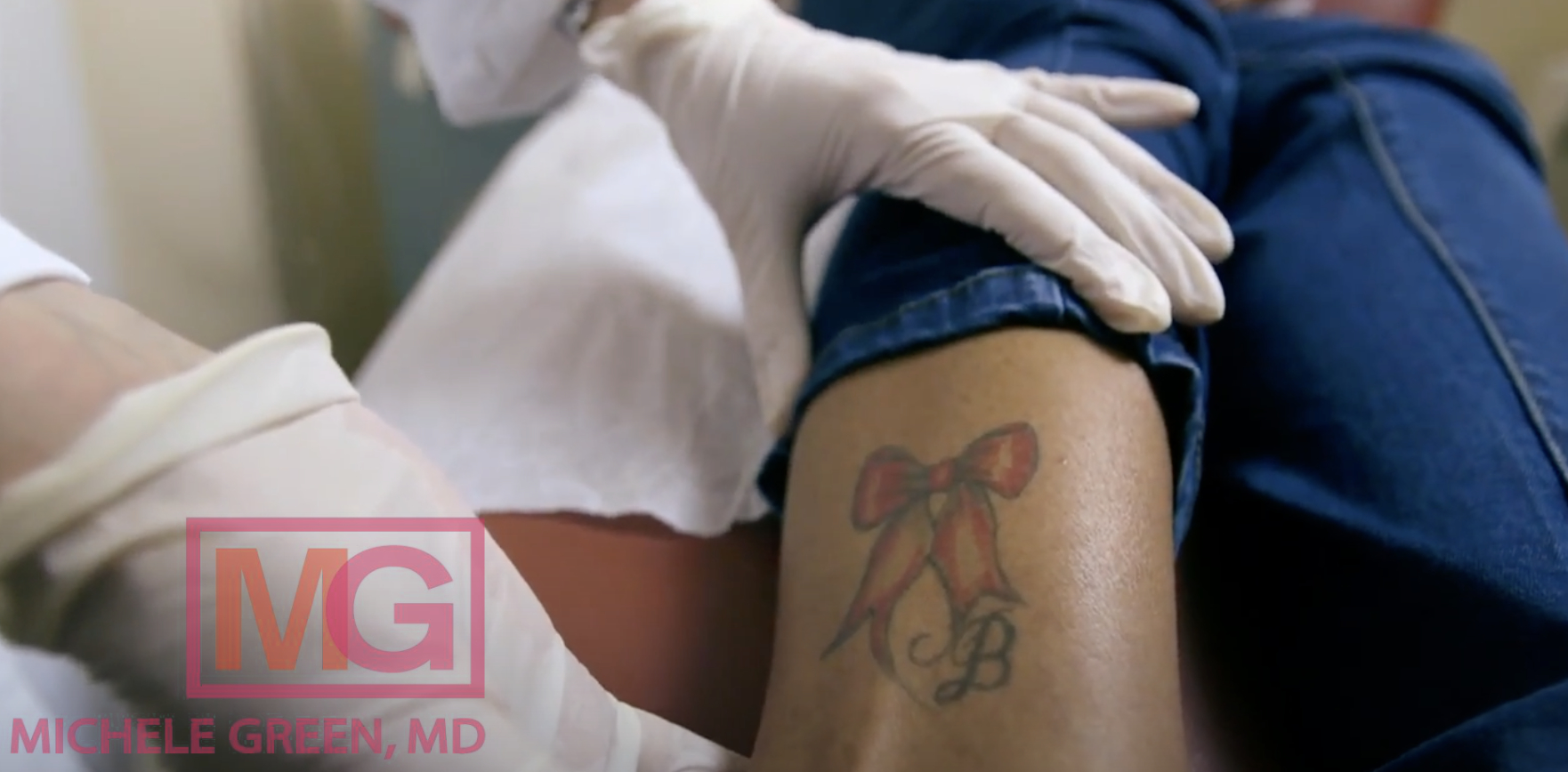
FAQs about Laser Tattoo Removal
When was laser tattoo removal invented?
Before laser tattoo removal was developed, early methods included surgical excision, dermabrasion, and cryotherapy. The first tattoo removal machines in the early 20th century used needles to break up ink particles, allowing the immune system to remove them. These methods were often unreliable, causing excessive skin damage and scarring. In the 1960s, the first laser tattoo removal was performed using a ruby laser. Lasers have proven effective for removing tattoos because they target specific pigments and minimize damage to surrounding skin, as different laser energies break down various tattoo inks. Early laser treatments often caused side effects like inflammation, scarring, and hyperpigmentation. Recently, laser tattoo removal techniques have been refined to be safer and more precise. The Candela Alex TriVantage Laser is a Q-switched laser that emits nanosecond pulses. It has become a trusted and effective method for tattoo removal, suitable for all skin types and a wide range of tattoo inks. At Dr. Michele Green’s luxury dermatology practice in NYC’s Upper East Side, she will guide you through the tattoo removal process with the Alex TriVantage to ensure safe and satisfying results.
Will laser tattoo removal completely remove a tattoo?
Today’s advanced laser technology enables the complete removal of tattoos in various colors. Darker tattoos can be fully removed through laser treatments. Black and blue inks tend to respond well because they absorb a wide range of light wavelengths. In past years, laser treatments struggled to effectively remove colored inks, which were particularly difficult to eliminate. The main challenge was that laser tattoo removal was similar to laser hair removal, targeting mainly dark colors like black. However, with recent technological advancements, this is no longer accurate. Devices like the Alex TriVantage laser can target multiple tattoo ink colors. It is important to understand that not all tattoos can be fully removed because tattoo ink is made of various organic and inorganic materials that might not be detected before treatment.
What does laser tattoo removal look like?
Immediately after a laser tattoo removal session, a “frosting” effect may appear, giving the skin a chalky look. Temporary skin lightening is a safe and normal part of the process, caused by the heat from the laser releasing carbon dioxide from the skin. The treated area may then develop common side effects like redness and swelling, which usually fade within a few hours. Other possible side effects include itching, blistering, scabbing, tenderness, or peeling, typically lasting up to two weeks as part of the skin’s natural healing. It’s important to keep the area covered with antibiotic ointment and avoid picking at blisters or scabs to promote proper healing. Wear protective clothing over the treated areas and apply sunscreen with SPF 50 between sessions to prevent hyperpigmentation. Reapply sunscreen every 90 minutes if you’ll be in the sun for a long time and the area is covered.
What does laser tattoo removal feel like?
Most patients describe the sensation of laser tattoo removal as if rubber bands are snapping against the skin in the treated area, often followed by a feeling of warmth. Some patients think that laser tattoo removal feels similar to getting a tattoo. While the laser tattoo removal process may cause some discomfort, it is temporary and tolerable. Dr. Green prescribes a topical anesthetic for all her patients that should be applied one hour before the laser treatment to minimize discomfort. When you arrive at Dr. Green’s boutique NYC dermatology office, the numbing cream will be removed, and the skin will be sterilized in preparation for treatment. For any tenderness or soreness in the treated area following the laser session, Dr. Green recommends taking Tylenol.
Does laser tattoo removal hurt?
No, laser tattoo removal is not painful. Many patients compare the sensation of having laser tattoo removal to a rubber band snapping against the skin. Dr. Green prescribes a topical anesthetic for her patients, which should be applied in a thick layer to the entire area to be treated one hour before the scheduled appointment. If the tattoo being treated is on an area that may be covered by clothing, a piece of plastic wrap can be placed over the numbing cream to prevent it from transferring to your clothes. An individual’s personal pain tolerance and the location of the unwanted tattoo can influence the amount of discomfort felt during the laser treatment, but the numbing cream helps significantly.
Does tattoo removal hurt more than getting a tattoo?
Some compare laser tattoo removal to the feeling of getting a tattoo. However, laser tattoo removal sessions are usually much shorter than the time it takes to get a tattoo, and the pain is generally mild in comparison. A topical numbing cream is also applied before treatment to help minimize discomfort.
How much does laser tattoo removal cost? How much to remove a small tattoo?
The cost of laser tattoo removal can vary based on several factors, including the size of the tattoo, the type of laser used, the experience level of the healthcare provider, and your geographic location. Other factors that may affect the overall cost include the tattoo’s location, colors, and age. If multiple tattoos are being removed or additional sessions are needed for complete removal, extra charges will apply. Since laser tattoo removal is considered a cosmetic procedure and is not medically necessary, insurance usually does not cover it. The price for small tattoos is typically lower than for larger ones.
Tattoo removal might be cheaper if done by a provider who is not a healthcare professional, such as at a medical spa. However, when someone other than a healthcare professional performs the procedure, the risk of dangerous or unwanted side effects increases. It is recommended to choose an experienced, board-certified dermatologist, like Dr. Michele Green in New York City, to minimize risks like hypopigmentation, hyperpigmentation, and scarring, and to ensure the best results. Dr. Green has over 25 years of experience offering top non-invasive treatments, including laser tattoo removal, to discerning clients worldwide. When you consult with her, she will help estimate the total cost and create a plan tailored to your needs, goals, and budget.
Does insurance cover laser tattoo removal?
Laser tattoo removal is usually not covered by most health insurance plans because it is generally seen as a cosmetic procedure rather than a medically necessary one.
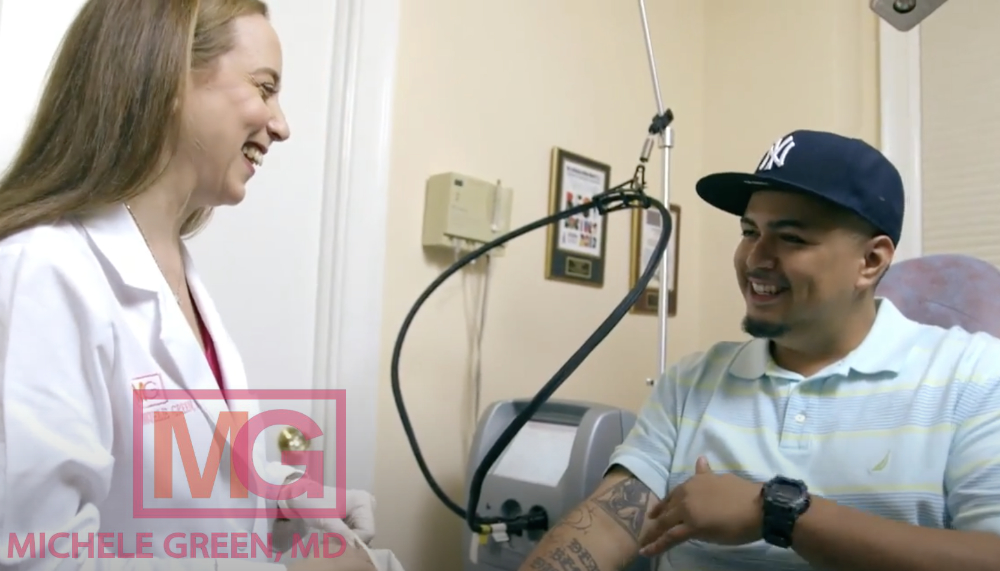
Is laser tattoo removal safe?
Yes! Thanks to modern laser technology, removing an unwanted tattoo is safer and easier than ever before. Various clinical studies have demonstrated the safety and effectiveness of laser tattoo removal treatments in patients with diverse skin types and tones. The laser device used by Dr. Green at her private dermatology office in NYC for tattoo removal, the AlexTriVantage, has been approved by the U.S. Food and Drug Administration (FDA). FDA approval indicates that laser tattoo removal has been thoroughly tested in numerous clinical studies and deemed safe and effective. To ensure safety, effectiveness, and optimal results while avoiding unwanted side effects, laser treatments should always be performed by a trained and experienced healthcare professional, such as board-certified dermatologist Dr. Michele Green in NYC. Seeking laser treatment from a MedSpa or similar facility can increase your risk of serious side effects, including hypopigmentation, hyperpigmentation, and scarring. An experienced, board-certified dermatologist like Dr. Green can adjust the laser treatment settings to match your skin type, tone, and the specific tattoo you want to remove.
Can you get laser tattoo removal while pregnant?
No. Pregnant or breastfeeding individuals are advised to avoid laser tattoo removal treatments. These treatments have not been evaluated for safety in pregnant or breastfeeding women. Due to the lack of data on effects on the fetus or baby, those who are pregnant or breastfeeding should wait to undergo the procedure. If you are currently pregnant or breastfeeding and interested in removing an unwanted tattoo, you can still schedule a consultation with Dr. Michele Green to discuss a future treatment plan. Dr. Green will gather a complete medical and family history, physically examine the tattoo, and review any prior treatments to develop an appropriate plan for your needs and goals.
Does laser tattoo removal cause cancer?
The Skin Cancer Foundation has concluded that laser tattoo removal does not increase the risk of skin cancer. However, it does make the skin more sensitive to sunlight. Increased photosensitivity means the skin is more vulnerable to damage from the sun’s UV rays, so avoiding sun exposure in the treated area is very important. In addition to limiting sun exposure, Dr. Green advises her patients to wear sun-protective clothing over the treated area and to use sunscreen. She typically recommends applying two different types of sunscreen for maximum protection: first, a chemical sunscreen, then a mineral sunscreen. Chemical sunscreens protect the skin by absorbing UV rays, converting the energy into heat through a chemical reaction, and releasing the heat from the body. Common active ingredients include avobenzone, oxybenzone, and octinoxate. Mineral sunscreens contain ingredients such as zinc oxide or titanium dioxide and work by forming a barrier that blocks UV rays from penetrating the skin. Always look for sunscreens labeled broad-spectrum, which protect against UVA and UVB rays, with a minimum SPF of 50 or higher. Patients with fair skin or a history of skin cancer should choose sunscreens with an even higher SPF.
Does tattoo removal damage skin?
One advantage of laser tattoo removal over other methods is that it selectively targets the tattoo ink, leaving the surrounding skin unharmed. Typically, the side effects are mild and usually resolve within a week after each treatment session. These include redness, swelling, bruising, scabbing, peeling, and blistering. It is important not to pick at the treated area if blistering, peeling, or scabbing occurs, as aggravating it can lead to increased inflammation, scarring, or hyperpigmentation. Unwanted side effects such as permanent scarring, hyperpigmentation, and hypopigmentation are more likely if an inexperienced or unqualified provider performs the procedure. Therefore, it is highly recommended to have laser tattoo removal done by an expert, like board-certified dermatologist Dr. Michele Green in NYC, to avoid permanent skin damage. Dr. Green is an internationally recognized dermatologist with over 25 years of experience providing top-tier non-invasive cosmetic procedures, including laser tattoo removal, and she will work with you to achieve the best results.
How sore is laser tattoo removal?
The skin in the treated area may be sore after tattoo removal, depending on the type of removal used, the location of the unwanted tattoo, and the patient’s overall pain tolerance. If there is any soreness in the treated area, Dr. Green recommends taking Tylenol as needed for relief. Side effects from laser tattoo removal, including tenderness or soreness in the treated area, usually resolve within one week of the procedure.
Can I shower after laser tattoo removal?
For the first three days after laser tattoo removal, keep the treated area bandaged and dry. It is okay to shower after the treatment, as long as the treated area remains dry. After three days, you can remove the bandage and clean the area in the shower. Dr. Green recommends taking precautions to protect the sensitive area and promote proper healing. The area should not be soaked or fully submerged in water, but it can be gently washed with a cleanser. After washing, pat the area dry carefully to avoid skin irritation. Baths, hot tubs, and swimming pools should be avoided during the laser tattoo removal process. When you have treatment with Dr. Green at her private dermatology office in NYC’s Upper East Side, she will give you all the necessary aftercare instructions to achieve the best results.
Can you swim after laser tattoo removal?
After your laser tattoo removal, avoid swimming until your treated area is fully healed. While your skin heals from the laser treatment, it is important to prevent irritation and support the healing process. After your procedure, apply antibiotic ointment and a bandage to prevent infection. Swimming before your skin has fully healed can increase the risk of skin irritants and infections. It can also delay healing of mild side effects such as blisters and scabs. Be sure to keep your healing skin clean and dry, and remember to wear sun-protective clothing and apply sunscreen. Proper aftercare is essential to achieve the best results and support your skin’s recovery. When you work with board-certified dermatologist Dr. Michele Green for your laser tattoo removal, she will guide you through the entire process to ensure optimal results.
Can I exercise after laser tattoo removal?
Strenuous exercise should be avoided for at least 48 hours following a laser tattoo removal treatment session. The treated area may be inflamed or sore for the first couple of days, and exercising can exacerbate inflammation or worsen other side effects, such as blistering and peeling. When you have laser tattoo removal with Dr. Green at her boutique dermatology office in NYC’s Upper East Side neighborhood, she will give you all of the aftercare instructions you need to get the best treatment outcome.
Does laser tattoo removal remove hair?
Laser tattoo removal generally doesn’t cause hair removal or affect hair growth. The laser light does not impact the hair follicles, although certain wavelengths of light might affect the pigment in darker hairs and temporarily remove them. If hair removal is the patient’s main concern, Dr. Green offers various types of lasers to achieve the best results.
Laser Tattoo removal – before and after 8 sessions
Does laser tattoo removal leave a scar?
When you have laser tattoo removal with an expert, such as internationally renowned, board-certified dermatologist Dr. Michele Green in NYC, the result is simply a visibly clearer complexion. It is essential to undergo laser tattoo removal treatment with an experienced, board-certified dermatologist like Dr. Green, who has the expertise needed to choose the right type of laser and settings tailored to your skin tone, type, and the specific tattoo you have. When an inexperienced or unqualified provider performs laser tattoo removal, the risk of dangerous and unwanted side effects, including hypopigmentation, hyperpigmentation, and scarring, increases. Dr. Green has over 25 years of experience in cosmetic dermatology and will ensure you get the results you desire.
The risk of scarring in the treated area also rises if the area is not properly cared for after the laser treatment. In the first several days following the procedure, the treated area should be covered with antibiotic ointment and a bandage to promote healing and protect the skin from irritation. Avoid excessively rubbing or touching the area to allow proper healing. After a shower or bath, gently pat the area dry with a towel instead of rubbing. It is crucial to keep the treated area clean, as it is more vulnerable to infection. Do not pick at the scabs that form, as this can damage the skin and slow healing. Protecting the treated site from sun exposure is also vital to prevent scarring. Laser treatment makes the skin more sensitive to UV damage. Let Dr. Green know if you have a history of abnormal scarring or keloids before undergoing laser tattoo removal.
Can you tattoo over laser tattoo removal?
Yes! Tattoos can be placed over an area that has been treated with laser tattoo removal. Instead of attempting complete removal, some patients undergo just enough sessions to fade the tattoo enough for a cover-up. The skin must finish healing before getting another tattoo in the same area. Dr. Green recommends waiting at least six weeks after your last laser removal session before booking a new tattoo appointment. Allowing the area to heal and your immune system to stabilize helps protect the new ink and ensures the best results. It’s also important to inform your tattoo artist about recent laser removal treatments, so they can advise on the best timing for your next tattoo.
How well does laser tattoo removal work?
Modern laser technology used for tattoo removal is regarded as one of the most effective and safest methods for eliminating unwanted tattoos. It is relatively painless and features a quick recovery period. A key benefit of laser tattoo removal is that it does not harm the surrounding skin, targeting only specific tattoo ink pigments. Today’s laser technology allows for the complete removal of tattoos, regardless of color and skin type, with fewer sessions, shorter downtime, and minimal discomfort. The outcome of laser tattoo removal and the number of sessions required depend on various factors, including the size of the tattoo, the person’s age, tattoo color, depth, ink quantity, and their overall skin condition and type. When you consult with Dr. Green about laser tattoo removal, she will gather a detailed medical and family history, physically examine the unwanted tattoo or tattoos, and review any previous cosmetic procedures you have undergone to ensure that laser tattoo removal will meet your needs and goals.
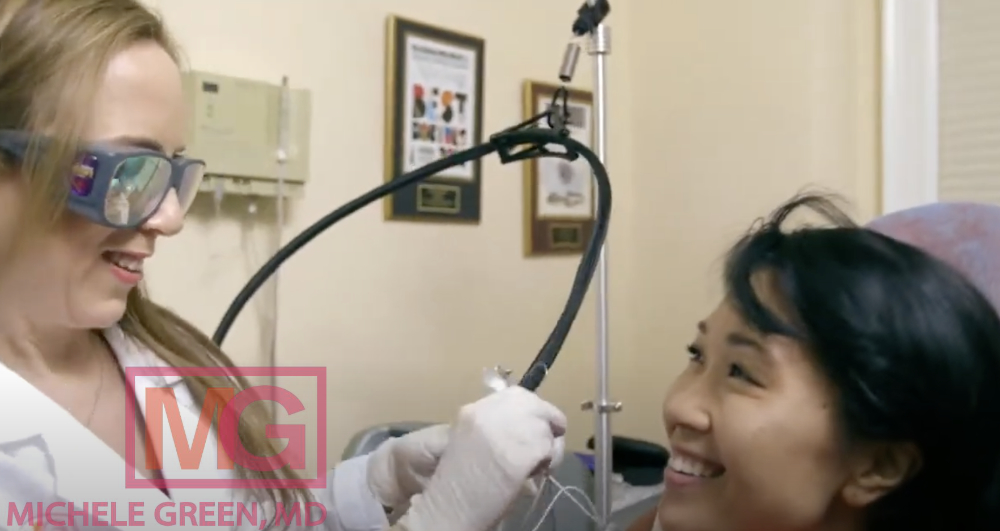
How to get started with laser tattoo removal in NYC today
An unwanted tattoo can be a significant annoyance and may even lead to feelings of self-consciousness. If you have a tattoo that no longer reflects who you are, has negative associations you’d like to forget, or is no longer cosmetically appealing, laser tattoo removal might be the right solution. Many tattoo artists will also request that an old tattoo be faded through laser removal before they perform a cover-up. The type of laser used must be suitable for your skin type and tone to reduce the risk of unwanted or adverse side effects. It’s always best to consult with a board-certified dermatologist, such as Dr. Green in New York City, to create a safe and effective plan for fading or removing your unwanted tattoo.
Dr. Michele Green is an internationally acclaimed, board-certified dermatologist with over 25 years of experience offering top non-invasive cosmetic treatments, including laser tattoo removal. She is regularly recognized as one of NYC’s premier dermatologists by Castle Connolly, New York Magazine, the New York Times, and Super Doctors, thanks to her dedication and expertise. Using the latest laser technology and innovative techniques, Dr. Green has helped many individuals achieve their ideal version of themselves. To begin the process of removing an unwanted tattoo with laser treatment, set up a consultation with Dr. Green by contacting us online or calling our NYC office at 212-535-3088.
 212-535-3088
212-535-3088 